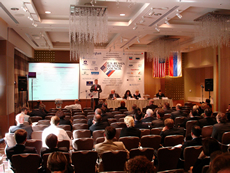FAQ'S
What is the difference between TRANSLATION and INTERPRETATION?
TRANSLATION is conversion of text from one language to another. INTERPRETATION is conversion of speech from one language to another. A TRANSLATOR converts text in one language into text in another language. An INTERPRETER converts speech (at a meeting, workshop or any other event) from one language to speech in another language.
What is the difference between SIMULTANEOUS and CONSECUTIVE INTERPRETATION?
SIMULTANEOUS INTERPRETATION (also known as CONFERENCE INTERPRETATION) occurs at the same time as, or simultaneously with, the speaker (delegate, discussant, conference participant, etc.) making a statement (report, presentation, comment, etc.) The simultaneous interpreter normally works in a soundproof booth, receives the speaker’s message through the earphones and renders it simultaneously into another language while speaking into a microphone. The audience receives the interpretation through their earpieces or headsets. A team of at least two interpreters is needed for SIMULTANEOUS INTERPRETATION.
In CONSECUTIVE INTERPRETATION, the interpreter listens to the speaker and interprets after the speaker completes one or two sentences.
What type of interpretation should I choose for my event?
Both forms of interpretation have their merits. In deciding whether to go with CONSECUTIVE or SIMULTANEOUS interpretation you have to consider the following factors:
CONSECUTIVE interpretation is time-consuming. It takes at least twice the time of the presentation, so in planning your event you should allow ample time for interpretation. This mode of interpretation is also limited to a maximum of two languages since otherwise it becomes quite impractical. Another consideration: the stop and start nature of CONSECUTIVE interpretation may disrupt the event dynamics. On the other hand, CONSECUTIVE interpretation is less costly than SIMULTANEOUS interpretation and makes for a more interactive environment for the meeting participants. It normally gives them a better chance to clarify their positions, clear up ambiguities, ask each other to repeat a statement as they move along and to determine the meaning of problem terms. It is recommended for sensitive one-on-one negotiations or medical interpreting.
SIMULTANEOUS interpretation is time-efficient and provides for a seamless flow of the event. Any number of languages may be accommodated. This mode of interpretation requires a booth per each language spoken and interpreted at the event, all relevant interpretation equipment (consoles, transmitters, microphones, headsets, etc.) and a sound engineer to set it up and monitor during the event. A team of at least two interpreters per each language combination (English and Russian, English and Spanish, etc.) is also needed. Simultaneous interpretation is recommended for workshops, seminars, lectures, debates and conferences – the meetings that are also referred to as UN-style events.
What type of equipment do I need for my event?
There is portable interpretation equipment and conference interpretation equipment with a soundproof booth. Portable interpretation equipment works best in a group of up to 40 people with 2 languages. No setup is required, apart from taking the equipment out of its carrying case and distributing the receivers and headphones among the meeting participants. It is a cost-effective solution for a smaller scale event. Conference interpretation equipment can be used for virtually any number of people in the audience and a multitude of different languages. This type of equipment is more complex and must be set up, monitored and dismantled by a professional sound technician. It is a more expensive option but has a lot of possibilities and is suitable for events of practically any style, format and scale.
How long is an interpreter's working day?
An interpreter's working day is normally eight hours, including a one-hour lunchbreak. If interpreters are needed for a longer day, then any time after eight hours is considered overtime and is billed as additional on top of the rate for the standard working day.
What cities do you provide interpretation in?
We strive provide interpretation in any location that our clients need. We will do our best to find local interpreters in major cities of the world. If local resources are not available, then we will choose the most cost-effective solution of travel for the interpreters who are based closest to the event venue.
How do you price your translation?
The price of translation depends on the document volume (the number of words to be translated), the complexity of the text and the turnaround time. Most often we will be able to give you an accurate estimate of the translation price before you agree to work with us.
What is the turnaround time for your translations?
The turnaround time depends on the length and complexity of the text. The standard turnaround rate in the industry is 1,500-2,000 words per business day. In case of a large translation project we will work with you to accommodate your deadlines. One of the options is to assign a team of translators and an editor to your project thus assuring a timely delivery and the highest quality of the translation.


